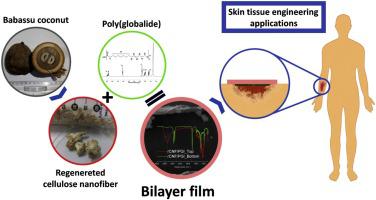Carbohydrate Polymers ( IF 11.2 ) Pub Date : 2020-10-13 , DOI: 10.1016/j.carbpol.2020.117201 Heliane R. Amaral , James A. Wilson , Ronaldo J.F.C. do Amaral , Irina Pasçu , Fernando C.S. de Oliveira , Cathal J. Kearney , Jair C.C. Freitas , Andreas Heise

|
Commercial cell-based skin regenerative products are highly expensive, carry the risk of rejection and require a long cell culture period to manufacture. This work describes the synthesis of bilayer films from poly(globalide) (PGl) and regenerated cellulose nanofibers (rCNFs) and their use as a cell-free scaffold to support keratinocyte attachment and proliferation. The method is simple, eco-friendly (as the cellulose precursor is obtained from agricultural waste) and of low cost. The rCNFs were produced by acid hydrolysis and PGl was obtained via enzymatic ring-opening polymerization. The bilayer films were synthesized by layer-by-layer casting at ambient temperature. All the films showed a well-defined interface between PGl and cellulose. The produced rCNF/PGl bilayer films showed cell metabolic activity far superior in comparison with pristine PGl regarding the keratinocyte growth, which illustrates the potential use of these materials in skin tissue engineering.
中文翻译:

由再生纤维素纳米纤维和聚(Globalide)合成双层膜,用于皮肤组织工程应用
商业的基于细胞的皮肤再生产品非常昂贵,具有排斥的风险,并且需要较长的细胞培养时间来制造。这项工作描述了由聚(Globalide)(PG1)和再生纤维素纳米纤维(rCNFs)双层薄膜的合成及其作为支持角质形成细胞附着和增殖的无细胞支架的用途。该方法简单,环保(由于纤维素前体是从农业废料中获得的),并且成本低廉。通过酸水解产生rCNF,并且通过酶促开环聚合获得PG1。通过在环境温度下逐层流延来合成双层膜。所有的膜在PG1和纤维素之间显示出明确定义的界面。


























 京公网安备 11010802027423号
京公网安备 11010802027423号